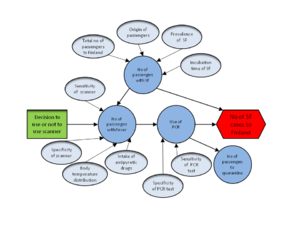|
|
| (21 intermediate revisions by 3 users not shown) |
| Line 19: |
Line 19: |
|
| |
|
| === Boundaries === | | === Boundaries === |
|
| |
| geographic boundaries of the assessment are limited within the boundaries of Denmark. Although this is one way but considering
| |
|
| |
| the fact that climate changing is a global matter. I addition this strategy focuses on what will be attainable in the individual
| |
| sectors within the next 10 years, therefore timing can be considered as a boundary as well.
| |
| Lack of more detailed socio-economic analysis in order to quantify the consequences of the suggested measures.
| |
|
| |
|
| === Decisions and scenarios === | | === Decisions and scenarios === |
| * Coastal management, dikes, ports etc.
| |
|
| |
| With the climate change happening vigorous storms and higher water levels in the sea will be expected that will lead to more risks of flooding and higher rates of erosion in areas along the coast. Maybe for preventing erosion land owners will enhance the amount of sand and channel dredging will be increased in areas that it is required. In some areas dikes or dunes as well as harbor installations and ferry baths can be reinforced. Since it is the landowner’s responsibility to protects itself from flooding and erosion no specific rule is required in this field. However, the Danish Coastal Authority will recommend minimum heights for building footings and dike heights upon request.
| |
| However,Minimum heights for building footings and dike heights upon request recommended by the Danish Coastal Authority.
| |
|
| |
|
| |
| * Buildings and infrastructure
| |
|
| |
| - Buildings
| |
| Autonomous adaptation must be expected with regard to limiting snow-load and storm damage as well as controlling indoor climate in particular. With respect to strengthening existing buildings that is the responsibility of individual building owners. A compulsory labeling regulation can be introduced.
| |
| No special, planned measures will be recommended for building extensions or renovation.
| |
|
| |
| - Roads and railways
| |
| Enhanced precipitation, groundwater levels, temperatures and winds will cause serious effects on the road and the road as well as the railways.
| |
| For efficient drainage to occur the size of the drainage system has to be adjusted and drainage has to be done adequately. Modern safety installation will be beneficial in railway. Autonomous adaptation to climate change as well as improved maintenance is crucial as well.
| |
| Road regulations and railway standards must be reviewed and revised in accord with the expected climate changes
| |
|
| |
| - Sewers
| |
| Precautions will be taken in order to minimise the extent of damage in the event of flooding. Payment regulations can be a motivator for property owners to undertake alternative surface-water drainage methods, such as percolation.
| |
|
| |
|
| |
| * Water supply
| |
|
| |
| Autonomous adaptation to climate change will be proposed when greater groundwater formation and increasing groundwater levels occur. Planning and reassessment of permits for water extraction will be undertaken sometimes Relocation of water extraction could occur as well. Socio-economic reassessment of water directives may be required in long term.
| |
|
| |
|
| |
| * Energy supply
| |
|
| |
| Increase in average temperatures and higher wind speeds will affect energy consumption as a result of climate change, winters lower energy for warming is required but warmer summers will need more energy for the cooling system. Increased wind speed can on the one hand lead to greater electricity production from wind turbines, but on the other hand, in storm situations wind turbines must be shut down to avoid storm damage. On the other hand district heating system can be used for producing district cooling.
| |
|
| |
|
| |
| * Agriculture and forestry
| |
|
| |
| CO2 concentrations and temperatures will increase which will lead to a longer growing season more agricultural products and introduction of new crops as well as different disease and insect patterns and an increased need for fertilizer. Two differnt stages are required in terms of climate change Short-term adaptation by optimizing the current conditions as well as Long-term adaptation that involves changes in agriculture's structure, technology and land use, irrigation systems, etc, as well as development and adaptation of new species and types of crops.
| |
|
| |
| The impacts of climate change can be taken into account in the evaluation and reassessment of existing and forthcoming regulations. Targeted research efforts into the impacts of climate change on agriculture will be required in order to make qualified economic calculations.
| |
|
| |
| * Fisheries
| |
| * Health
| |
| * Land use planning
| |
| * Nature management
| |
|
| |
|
| === Timing === | | === Timing === |
|
| |
| This strategy focuses on what will be attainable in the individual sectors within the next 10 years. By "attainable" is meant that a measure should be scientifically, technically and socio-economically appropriate for implementation within the given period
| |
|
| |
|
| == Answer == | | == Answer == |
